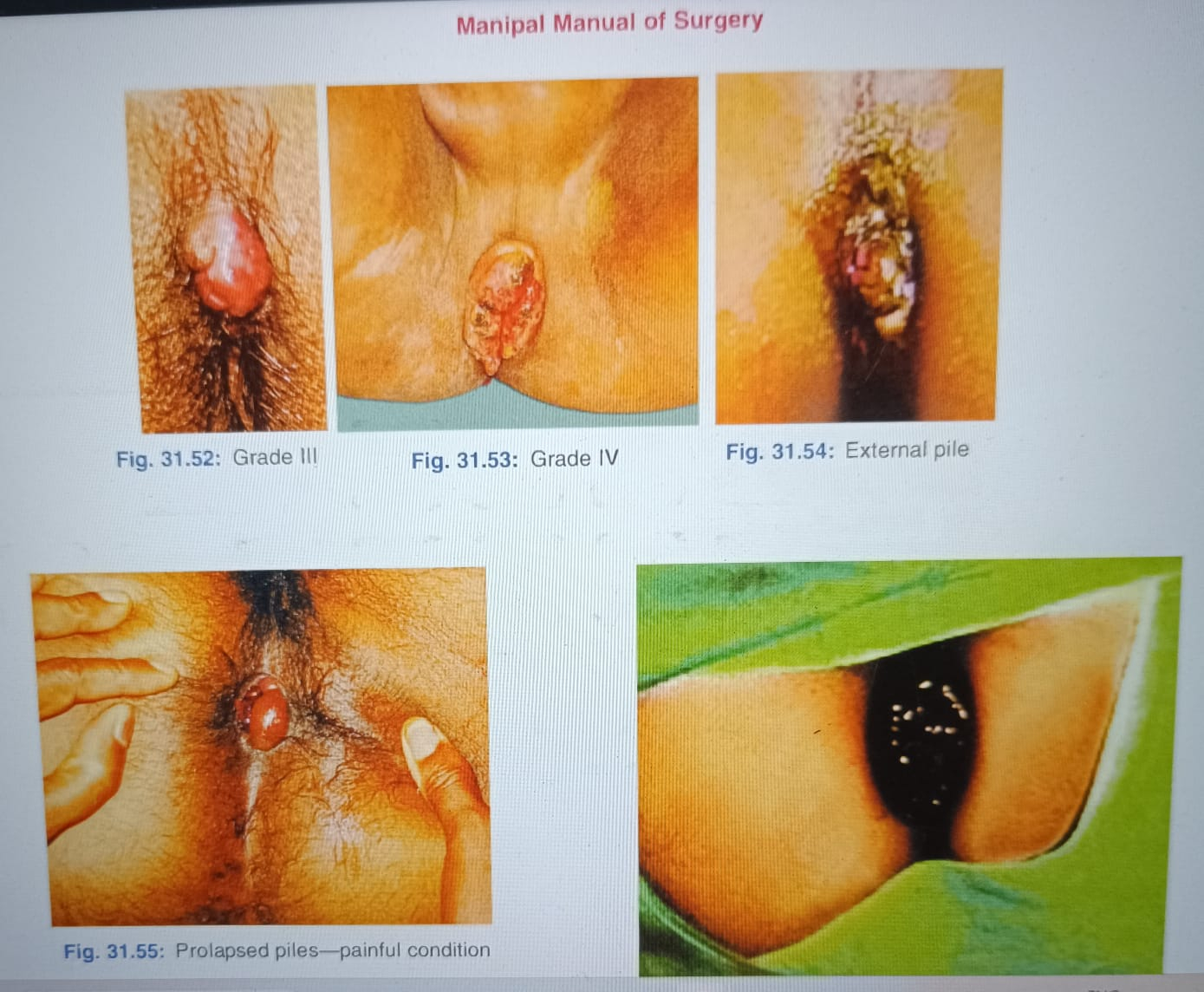



Definition
Dilated plexus of superior haemorrhoidal veins, in relation to anal canal.
Classification-aetiological
I. Primary/Idiopathic haemorrhoids
1. Standing posture: It has been told nicely that varicosity is the penalty for verticality against gravity. It is also true for haemorrhoids. It is true that animals do not develop haemorrhoids. Thus man's upright posture and absence of valve in the portal system with other factors precipitate development of haemorrhoids
2. Haemorrhoidal veins and their branches are the thin veins which pass through submucosa of the rectum. They get compressed due to contractions caused by rectal musculature (the sphincters) during the act of defaecation.
3. Genetic/ familial factors: Absence of valves, or congenital weakness of the vessel wall are few other factors contributing for the haemorrhoids
4. Diet: A diet deficient in fibres which prolongs the gut transit results in constipation and small hard pellet like stools. The hard stools compress veins and result in haemorrhoids.
II. Secondary haemorrhoids
Causes
1. Carcinoma of rectum, by blocking the veins, can produce back pressure and can manifest as piles.
2. Portal hypertension-uncommon cause of rectal varices.
3. Pregnancy, due to compression on superior rectal veins or due to progesterone which relaxes smooth muscle in the wall of the veins, can cause haemorrhoids.
Current view: Latest theory is that haemorrhoids occur due to caudal displacement of anal cushions. It is due to recurrent trauma, shearing forces, loss of elasticity. Thus normally the cushions retract after defaecation.
Location
Classically situated in the 3, 7, 11 o'clock positions (left lateral, right posterior and right anterior respectively).
• Superior haemorrhoidal artery (vein) gives 2 branches on right side and I branch on left side. Hence, piles are two on right side (3 & 11 o'clock positions) and one on left side. (7 o'clock position)
Clinical features
• Painless bleeding-fresh bleeding occurs after defaecation Splash in the pan. This causes chronic anaemia. Haemorrhoids which bleed are called Grade I haemorrhoids.
• The capillaries of the lamina propria are only protected by a single layer of epithelial cells. Hence, minor trauma precipitates bleeding.
• As the straining increases, the haemorrhoids partly prolapse outside. After defaecation, it returns back (Grade II) or can be digitally replaced (Grade III haemorrhoids).
• Permanently prolapsed pile outside (Grade IV haemorrhoids). The patient complains of pain or discomfort.
• Most of the patients complain of constipation.
• Discharge of mucus and soiling of perianal skin-pruritus by prolapse of haemorrhoidal cushions and mucosa
Depending upon the location of haemorrhoids
1-Internal haemorrhoids-above the dentate line, covered with mucous membrane.
2. External haemorrhoids-at anal verge, covered with skin.
3. Interno-external-both varieties together.
Complications of haemorrhoids
1. It can cause chronic anaemia.
2. A prolapse outside presents with severe pain in the perianal region-piles gripped by internal sphincter results in venous congestion and oedema followed by strangulation.
3. Ulceration and secondary infection
4. Thrombosis and fibrosis
NONOPERATIVE TREATMENT
• Fibre supplementation
• Increased fluid intake
• Bulk purgative-laxatives-isabgol l husk, etc.
• Reading in toilet to be discouraged (respond to call and do not strain)
• Encourage to lose weight
TREATMENT AT DR. SOHAN LAL CLINIC
The integrated POLYCLINIC facility offers patients to select their treatment either from the Department of Homeopathy or from the Department of Medicine.
We provide scientific, research-based, and professional services to people across the world, aiming to achieve the highest success rate.
